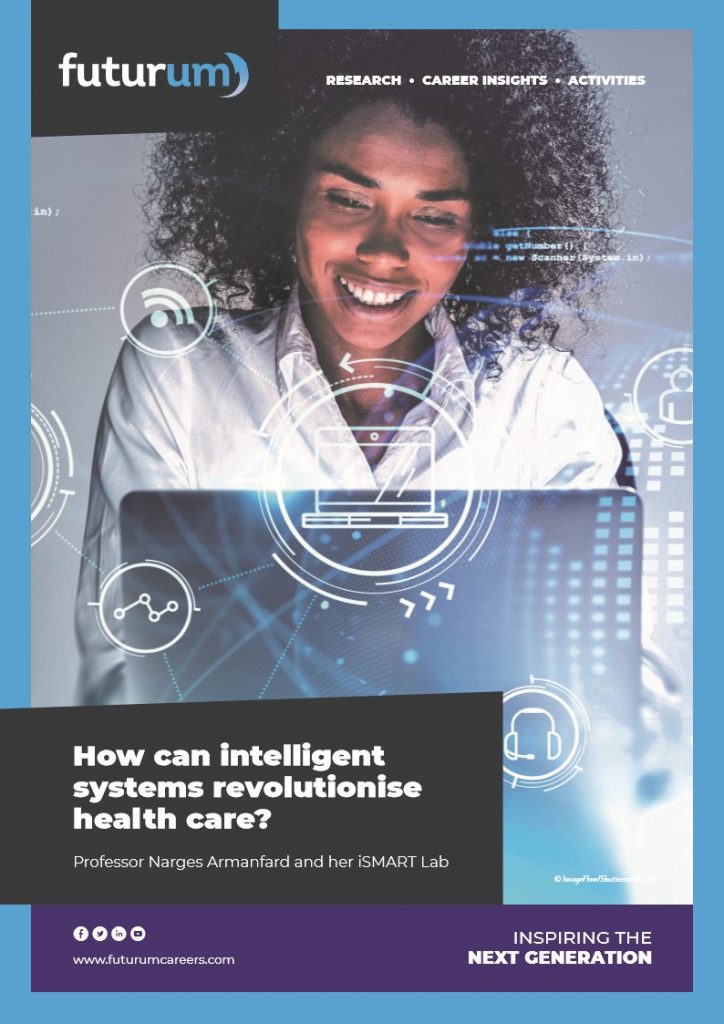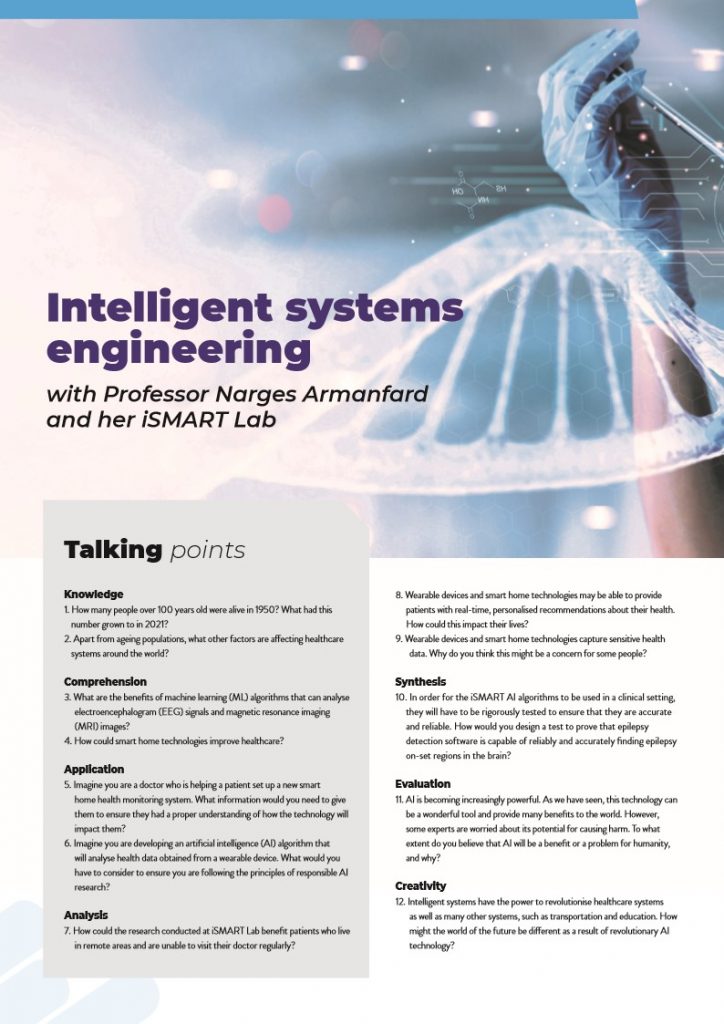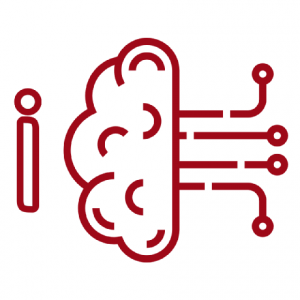How can intelligent systems revolutionise healthcare?
Access to quality healthcare is a basic human right. Without doctors, nurses and hospitals, our societies would cease to function. However, all over the world, the pressure on healthcare systems is mounting due to ageing populations and many other factors. Dr Narges Armanfard from McGill University and Mila Quebec AI Institute in Montreal, Canada, has set up iSMART Lab to develop intelligent computer systems that can support medical professionals.
Talk like an intelligent systems engineer
Algorithm — a sequence of rigorous instructions or rules that are used to solve complicated problems
Artificial intelligence (AI) — the replication or simulation of human intelligence using machines, especially computers
Bias mitigation — preventing or reducing unconscious bias (that can impede human reasoning)
Intelligent systems — advanced machines or computers that are able to perceive and respond to the world around them
Machine learning (ML) — computer systems able to learn and adapt without following specific instructions
Responsible AI research — AI research that ensures new advancements do not put anyone at risk of exploitation or harm
Telemedicine — using electronic communication devices to provide health care when the doctor is not in the same location as the patient
Wearable devices — small devices, such as a wristband or implant, that an individual wears to monitor their physical condition
Thanks to medical advancements and better lifestyle choices, humans are now living much longer than we used to. In 1950, the United Nations estimated that there were 23,000 people around the world who were over the age of 100. By 2021, that estimate had rocketed to 573,000.
As we get older, we start to encounter more health complications. For example, the World Health Organization estimates that 47.5 million people live with dementia worldwide, and this figure is expected to increase. Although our ability to treat age-related diseases has improved dramatically over the last few decades, health care systems are beginning to feel the strain of caring for an ageing population.
Medical waiting lists are getting longer, hospitals are running out of beds, and doctors and nurses are burning out. These problems are caused by several factors, including consequences of the COVID-19 pandemic, increasing rates of obesity, and a lack of staff and funding. To ease the pressure on our struggling healthcare systems, scientists and medical professionals are looking to innovative new technologies such as machine learning (ML) and artificial intelligence (AI).
Dr Narges Armanfard, from the Department of Electrical and Computer Engineering at McGill University and Mila Quebec AI Institute in Montreal, has established iSMART Lab to develop new healthcare technologies. “iSMART Lab is at the forefront of developing cutting-edge technologies for health monitoring through the use of intelligent systems,” says Narges. “My iSMART Lab is attempting to revolutionise how healthcare professionals and individuals monitor and manage their health.”
Patient well-being
Intelligent systems are innovative computer systems that can perceive and respond to the world around them. One key aspect of such systems is AI algorithms, which can analyse vast amounts of data in a short space of time.
By analysing data from various sources, such as wearable devices, health records and lifestyle habits, these systems can provide personalised insights into an individual’s health. This can enable people to make informed decisions and take proactive measures to maintain their wellbeing. “Whether it’s tracking physical activity, monitoring vital signs, analysing sleep patterns or brain activities, intelligent systems can provide real-time feedback and recommendations to encourage healthier habits, behaviours, and early and accurate diagnosis and prognosis that may not be evident to the human eyes,” explains Narges. Intelligent systems can act as virtual assistants to individuals and healthcare practitioners. For example, these systems can guide older adults or people with dementia by offering reminders for taking medicine, suggest healthy recipes, or curate exercise routines that can help people stay fit and reduce the risk of certain diseases.
Intelligent systems can offer personal guidance based on their analysis of a person’s health data. “This can enable individuals to actively participate in management of their own health, empowering them to lead healthier, more balanced lives,” says Narges. Additionally, intelligent systems can help to detect early signs of abnormalities in the brain, tailoring treatment plans for individuals with brain disorders. “Early detection of abnormal activities and related abnormal areas in the brain can assist neurologists to help patients manage their conditions and minimise the brain disorder’s severity to improve a patient’s quality of life,” explains Narges.
Aiding healthcare providers
Intelligent systems can provide invaluable assistance to healthcare providers and have the potential to transform patients’ experiences of the healthcare system. “By leveraging AI algorithms, these systems can detect patterns and trends in patient data that may not be easily identifiable to human observers,” explains Narges.
Healthcare professionals will be able to detect diseases at an earlier stage, enabling them to make more accurate diagnoses, predict potential complications, and personalise treatment plans to best suit each patient. “Additionally, intelligent systems can streamline administrative tasks such as documentation, scheduling and billing, allowing healthcare providers to allocate more time and attention to direct patient care,” says Narges.
Reference
https://doi.org/10.33424/FUTURUM426
Intelligent systems can also facilitate better communication and collaboration between healthcare teams. “These systems can securely store and share patient information, ensuring that healthcare professionals have access to comprehensive and up-to-date data, regardless of geographical location,” says Narges. This seamless flow of information enables different teams to coordinate, makes the delivery of care more efficient and reduces the chances of errors being made due to miscommunication or confusion. Another advantage of intelligent systems is that they can support telemedicine and remote monitoring. This allows doctors to monitor their patients, consult with them and make decisions about their treatments from afar. This could be particularly important in areas that lack access to sufficient healthcare facilities, or during emergencies, such as natural disasters and pandemics.
iSMART Innovations
“The projects we work on aim to transform the monitoring and management of health conditions,” says Narges. By combining AI algorithms with new monitoring technologies, iSMART’s projects enable real-time, non-invasive monitoring of patients from within the comfort of their own homes. This approach allows doctors to collect data continuously and over longer periods of time, allowing them to provide personalised treatments that specifically address the needs of each patient. Moreover, iSMART aims to provide software platforms whose output will be a great asset to neurologists to make prompt diagnosis and treatments for patients with brain disorders.
What makes iSMART Lab projects unique is their ability to analyse a range of data sources, including video recordings, audio signals, physiological signals, movement patterns and environmental data. Integrating AI and smart-home technologies into these intelligent systems can empower individuals to actively manage their own conditions and improve their quality of life. As another example, integrating AI into the brain analysing intelligent systems facilitates predictions of a disease’s progression, allowing neurologists to make informed decisions about treatment strategies and care planning.
The AI revolution
“AI has the potential to revolutionise our lives in numerous positive ways,” says Narges. “Responsible AI research and development can lead to advancements in various fields, including transportation, education and sustainability.”
AI could optimise our transport systems by reducing congestion, planning out delivery routes for goods vehicles, and controlling self-driving cars. In education, AI can personalise learning experiences to suit a person’s preferred learning style, encouraging engagement. In the world’s fight against climate change, AI algorithms can help by monitoring carbon emissions, predicting changes to weather patterns and optimising our energy use.
“The iSMART Lab plays a crucial role in driving responsible AI research and development,” says Narges. “The lab is prioritising ethical considerations, transparency and accountability in AI systems by focusing on fairness, bias mitigation and privacy protection.” The iSMART Lab will help ensure that AI technologies are developed with the well-being and rights of individuals as priorities.
“The lab also promotes interdisciplinary collaboration, bringing together experts from various fields to address societal challenges and explore the potential of AI for positive impact,” explains Narges. The iSMART Lab is developing guidelines and frameworks for responsible AI ensuring that AI is used ethically and in a responsible manner to benefit humankind, rather than control it.
 Professor Narges Armanfard
Professor Narges Armanfard
iSMART Lab, McGill University and Mila Quebec AI Institute in Montreal, Canada
Field of research: Intelligent Systems
Research project: Developing cutting-edge technologies for health monitoring
Funders: McGill University, Fonds de Recherche du Québec, AGE-WELL, Vanier Canada Graduate Scholarships, Natural Sciences and Engineering Research Council of Canada
Zero-effort health smart home
Smart home technologies are devices that can monitor a patient’s health from within their own home. “The aim of health smart home (HSH) is reducing pressure on the health system while providing timely e-health services to its occupants (e.g., older adults) wishing to live in their own homes and maintain their independence,’’ says Narges. “Zero-effort-HSH (Z-HSH) aims to realise HSH goals so that neither active interaction or compliance from the user is required, and the user does not need to wear any sensor or device. More specifically, in Z-HSH, technology is embedded into the common household items and does not interfere with the daily activities of the smart home occupants,’’ explains Narges. Hadi Hojjati, a PhD student working on this topic under supervision of Professor Narges Armanfard, is developing advanced AI algorithms that can analyse massive amounts of health data to ensure healthcare professionals can make the most of these smart home technologies.
What are the healthcare benefits of smart home technologies?
Smart home technologies are more convenient than traditional methods and reduce the need for frequent hospital visits. They are also able to collect data continuously, throughout the day and night, which helps doctors make informed decisions about a patient’s health.
“Health smart home devices can capture physiological signals, such as heart rate and blood pressure, as well as track users’ sleep patterns, steps taken and calories burned,” explains Hadi. “For instance, wearable devices like fitness trackers or smartwatches can continuously monitor the heart rate and provide insights into users’ physical activities, such as walking or running.” One of the key advantages is early detection of health issues. “For example, sensors can monitor movements and identify unusual patterns that may indicate a fall or decline in mobility, allowing caregivers to intervene quickly,” says Hadi.
What makes analysing data from smart home sensors so challenging?
Smart home sensors are continually collecting large volumes of complex and variable data. Additionally, each patient’s data will exhibit their own unique patterns and trends, which make analysing and comparing datasets more difficult.
“Traditional analytical approaches may struggle to handle this variability and extract meaningful insights,” says Hadi. “To tackle these challenges, deep-learning methods are being developed which can automatically learn and identify patterns from vast amounts of data.” These deep-learning algorithms aim to improve the accuracy, efficiency and personalisation of healthcare based on smart home sensor data. They enable doctors to better understand health conditions and individual needs, which can lead to more effective and targeted treatments.
What privacy issues need to be considered?
“When developing health smart home algorithms, it is crucial to address privacy concerns to safeguard personal information,” says Hadi. Smart home devices gather sensitive health-related data which must be stored securely. Smart home devices must have robust security measures to prevent unauthorised access and protect patients’ privacy.
“Informed consent emerges as another critical aspect,” says Hadi. Users should be aware of the data that are being collected, how they are used, and who has access. Smart home devices should prioritise transparency and give patients control over their own data, allowing them to opt-out, delete data, or increase their privacy.
What challenges does this research pose?
One challenge that Hadi and iSMART Lab face is the lack of well-developed algorithms in this area. The team must invest time and resources into developing new algorithms that are specifically designed for analysing smart home data.
Another challenge is the lack of comprehensive datasets that the team can use to train and test their new algorithms. “Unlike other domains where large datasets are readily available, smart home datasets are often limited and fragmented, mainly due to privacy regulations,” explains Hadi. “The iSMART Lab team must overcome this hurdle by curating or creating their own datasets, which requires significant effort and expertise.”
How successful has this research been?
Hadi and the iSMART team have demonstrated that smart home sensors can effectively record information about physiological signals such as a patient’s heart rate or blood pressure. As they continue to refine their algorithms, they will be able to analyse these signals in more detail.
For example, Hadi is hoping to use multimodal learning, which involves combining data from multiple kinds of sensors, to create a more complete view of a patient’s health. “Providing more accurate and insightful health monitoring solutions will open up a lot of possibilities,” he says. “We can keep track of our health at a much lower cost, making healthcare more accessible and affordable for everyone.” Smart home technologies could replace the need for expensive equipment and frequent visits to hospitals.
AI for brain disorders
The projects at iSMART Lab go beyond smart home technologies. Thi Kieu Khanh Ho is a PhD student, under the supervision of Professor Narges Armanfard, investigating how advanced AI algorithms can help medical professionals detect and diagnose epilepsy.
How is epilepsy detected?
There are currently two main methods for detecting epilepsy: electroencephalograms (EEGs) and magnetic resonance imaging (MRI). An EEG involves placing electrodes on a patient’s scalp or surgically embedding electrodes into a patient’s brain. These electrodes are used to record electrical activity within the brain and help to identify abnormal brain activity, such as seizures, or seizure on-set zones, the parts of the brain where the seizures originate. “On the other hand, MRI is an imaging technique that provides detailed structural images of the brain and helps neurologists to identify the underlying cause of epilepsy,” explains Khanh. Currently, medical professionals must visually study these brain signals and images besides patients clinical information to identify any brain abnormalities which might be causing the seizures. This can be a very time-consuming and costly process. “Our experiments, in collaboration with the Montreal Neurological Institute, confirm that there could be important information hidden in the patient’s brain related data that cannot be discovered by human eyes,’’ says Narges.
How can AI algorithms help?
To tackle these challenges, Khanh is developing new AI algorithms that will be able to use EEGs and MRIs to automatically detect seizure on-set zones. These will be self-supervised learning (SSL) algorithms, meaning that they can make sense of and categorise raw, unlabelled data, saving medical professionals time and money.
Khanh is developing separate algorithms that analyse data from scalp EEGs, intercranial (within the cranium – or skull) EEGs, and MRI images. However, she is hoping to integrate these three methods into one SSL-based multimodal technique that will be better able to identify seizure on-set zones and other abnormal regions.
What impact could this have on epilepsy treatment?
One common form of epilepsy treatment is resective surgery, where the part of a patient’s brain which is causing seizures is removed. “The ultimate product of our epilepsy project is a software platform which will be a great asset to neurologists when deciding which brain regions must be resected during epilepsy surgery,” says Khanh.
Could these AI algorithms be applied to other brain disorders?
“Our proposed AI framework aims to detect abnormal brain activities and related brain regions in epilepsy patients using different modalities, namely EEG signals and MRI images,” says Khanh. “The current practice of identification of other brain disorders is also mainly based on these modalities.” As a result, Khanh believes her algorithms could be used to detect abnormal brain activity and the related brain regions of other brain disorders.
What are the challenges of this research?
This research requires interdisciplinary collaboration between computer scientists and neurologists. Khanh’s job as a computer scientist is not only to develop AI models that can accurately detect abnormal brain activity, but also to ensure the findings of these models can be interpreted properly.
“Understanding the reasons behind a model’s decision is important to validate the findings, gain insights and ensure the reliability of the model,” explains Khanh. “At the same time, we need to incorporate the knowledge of neurologists, who are experts in recognising abnormalities and able to evaluate the performance of our models.”
Once Khanh has succeeded in creating AI models that are accurate and reliable, moving these models from research into clinical practice will be a significant challenge. The models must be rigorously tested and validated, and integrated into existing clinical practices. “As the EEGs and MRI datasets are continuously generated, our models must be adaptable and capable of handling new data to yield up-to-date and accurate predictions,” she says.
What successes has this project achieved so far?
“We have verified our self-supervised method on detecting and localising seizures using the largest publicly available scalp EEG seizure dataset,” says Khanh. The team was able to show that its self-supervised learning method overcame many of the problems faced in previous seizure detection research. This method also significantly reduced the time and resources needed to achieve successful detection.
What are the next steps for this project?
Khanh’s main focus is finalising the AI framework which will integrate data from both EEG signals and MRI images. She says, “We will also consult the opinion of neurologists on the performance of our methods, then we will apply our methods to the identification of other brain disorders.”
Pathway from school to intelligent systems engineering
• It is essential to have a strong foundation in technical skills and knowledge. Studying physics, maths and computing at school and post-16 years is a good place to start.
• Staying up to date with the latest advancements in the field of AI and ML is important.
• Work on your problem-solving skills. Being able to break down complex problems and find innovative solutions will be helpful.
• Persevere and be resilient. The ability to embrace failures as learning opportunities will help you grow as a scientist.
• Practise your communication skills. Being able to convey complex concepts in a clear manner can help you share your work and collaborate with others. Strong interpersonal skills will also help you make connections and work effectively with a range of people.
Explore careers in intelligent systems engineering
• There are many places online that you can visit to learn more about intelligent systems and AI including The Society for Intelligent Systems, the Association for the Advancement of Artificial Intelligence, and the AI Association.
• Many universities run summer schools dedicated to machine learning and AI. Contact your local university to see whether they have any opportunities, or follow this link to see a list of summer schools from all over the world.
Meet Narges
As the founder of the iSMART Lab, I firmly believe in the power of teamwork and effective leadership. I recognise that innovation thrives in collaborative environments where diverse talents converge towards a common goal. My philosophy centres on fostering an inclusive and dynamic atmosphere where each member’s strengths are harnessed and contributions valued. Through open communication, shared vision and a commitment to continuous learning, I aim to cultivate a strong sense of camaraderie within iSMART Lab. By leading with empathy, integrity and a dedication to empowering my team, I strive to inspire and guide individuals to reach their full potential and collectively drive impactful research and advancements.
I have always had a curiosity and passion for understanding how things work and solving complex problems. This natural inclination towards science and technology sparked my interest in pursuing a field where I could delve into the intricacies of electrical and computer systems.
I am inspired by the trailblazing women who have made significant contributions to the field of engineering. Their perseverance, resilience and determination in breaking gender barriers motivate me to follow in their footsteps and contribute to increasing diversity and representation in the field. I am inspired by their stories of overcoming challenges and defying societal norms, proving that women can excel and thrive in engineering and STEM disciplines.
The mentors and professors during my academic journey have played a crucial role in shaping my career choice. Their mentorship has not only provided me with technical knowledge but also instilled in me the desire to make a positive impact through my work.
Establishing iSMART Lab has been the culmination of my passion for AI, research and societal impact. Throughout my academic journey, I witnessed the transformative potential of AI and its applications in various domains. I was driven by a desire to contribute to the advancement of AI technology and harness its power for the greater good.
I noticed the need for a dedicated research space that focuses on responsible AI development and interdisciplinary collaboration. I envisioned a lab where innovative ideas could flourish, ethical considerations could be prioritised, and diverse perspectives could be embraced.
I wanted to create an inclusive environment that promotes diversity and encourages the participation of underrepresented groups in AI research and development. iSMART Lab became a space where aspiring researchers, especially young women, could find support, mentorship, and opportunities to thrive in the field of AI.
It is immensely satisfying to witness the growth and success of lab members, seeing their ideas come to fruition and contribute to advancing knowledge and technology. Leading a lab provides a platform to mentor and guide aspiring researchers, shaping their careers and empowering them to make their own contributions to the field.
Leading a lab also comes with challenges. Managing resources, securing funding, and maintaining a productive and cohesive research environment require careful planning and coordination. Balancing administrative responsibilities with research and teaching commitments can be demanding and time-consuming. Moreover, fostering collaboration and maintaining effective communication within a diverse team can present its own set of challenges.
To switch off from work, I prioritise self-care and maintain a healthy work-life balance. Engaging in activities outside of work helps me recharge and maintain a fresh perspective. I make sure to set boundaries and allocate dedicated time for relaxation, hobbies and spending quality time with loved ones.
To overcome obstacles, I seek support from my professional network and engage in open conversations with colleagues and mentors. Sharing experiences, challenges and strategies with others in the field helps me gain new insights, find innovative solutions and overcome obstacles more effectively.
I am proud of my contributions to cutting-edge research projects that have pushed the boundaries of AI technology. From developing novel algorithms to tackling real-world problems, these research endeavours have allowed me to make a tangible impact in the field and advance knowledge in AI.
I am also proud of my role as a mentor and educator. Guiding and inspiring the next generation of AI researchers is immensely fulfilling. Seeing my students grow, succeed and make their own mark in the field brings me a sense of pride and accomplishment.
I aspire to continue pushing the boundaries of AI technology through innovative research projects that address critical challenges. Whether it is developing more robust and explainable AI algorithms, exploring the ethical implications of AI, or leveraging AI for social good, I aim to contribute to the development of AI solutions that benefit individuals and communities.
I aspire to advocate for and actively work towards increasing representation of women and underrepresented groups in the field. By promoting diversity in perspectives, experiences, and backgrounds, I believe we can develop AI technologies that are more inclusive, unbiased and aligned with societal needs.
Meet Hadi

From a young age, I was naturally drawn to mathematics and science. I found joy in deciphering complex concepts and unravelling the inner mechanism of systems. As I grew older, this passion evolved into a deep fascination with technology and its potential to transform society. Electrical engineering emerged as the ideal path for me to explore this passion further and contribute to the advancement of technology-driven solutions.
Throughout my academic journey, I have sought opportunities to enhance my engineering skills and broaden my knowledge. I have participated in research projects and internships which have provided me with invaluable hands-on experience and exposure to real-world engineering problems.
The focus of my PhD thesis is on developing novel deep-learning methods for processing temporal data, such as videos and physiological signals. My personal belief is that, currently, there is a gap between the theoretical development of novel deep-learning methods and their applications in real-life, and my personal goal is to fill this gap to the best of my ability.
When you have a passion for your job, it becomes more than just a means of earning a living. It fuels your motivation, creativity and dedication. Being genuinely interested in your work allows you to approach tasks with enthusiasm and a positive mindset. It enables you to invest time and effort in continuous learning and growth within your field, ultimately leading to improved performance and success.
In today’s fast-paced and competitive world, being attentive to timelines is of paramount importance. Meeting deadlines is a sign of reliability and demonstrates your ability to manage your time effectively. Consistency is another vital attribute that helps build a reputation for reliability and dependability.
I take pride in the fact that my research projects have translated into tangible outcomes and have been disseminated to the scientific community through the publication of research papers.
My goal is to drive innovation and develop breakthrough technologies that have a significant positive impact on society. I aim to lead and mentor the next generation of signal-processing professionals, inspiring them to push the boundaries of knowledge and make groundbreaking contributions to the field.
Meet Khanh

My enthusiasm for electrical and computer research first took root when I received a scholarship to do an internship at the Machine Learning and Vision Lab at the Gwangju Institute of Science and Technology in South Korea. During that internship, I had a great opportunity to participate in an inspirational international conference held in Japan. Since then, I have been passionate about becoming a ML scientist who can develop effective AI algorithms to address many challenges existing in the biomedical field.
I am hard-working, passionate and self-motivated to pursue my research goal of developing ML algorithms to tackle biomedical challenges. I am always open to new and innovative ideas, which inspires me to push the boundaries of my current research.
I have been selected to become a Vanier scholar, a prestigious and highly competitive scholarship for doctoral students in Canada. Being a Vanier scholar, I will use financial resources to support my PhD study and connect with other researchers in the field.
I would like to become a ML scientist to develop effective algorithms for identification of a variety of disorders. Although I believe that ML cannot replace medical experts on a large scale, it can provide valuable findings that can help them in the diagnosis and treatments of diseases and disorders.
Do you have a question for Narges, Hadi or Khanh?
Write it in the comments box below and Narges, Hadi or Khanh will get back to you. (Remember, researchers are very busy people, so you may have to wait a few days.)














I worked in the United States healthcare system. As you may know the United States healthcare system is the most expensive in the world taking almost 20% of GDP and leaving 10% of the population without healthcare coverage. U.S outcomes are just in the middle of other countries with universal healthcare systems. An access is a problem for many types of healthcare services.
Smart healthcare systems may be a way to allow less expensive healthcare providers like PA or NP to provide better service And Smart healthcare system may allow for quicker intervention to avoid costly hospialixzation or ER visits.
I would like to work on aiding your lab as a volunteer to assist with efforts to make Smart healthcare system operational to make healthcare better in the United States as well as provide applications for developing countries to leapfrog their healthcare system to provide comparable healthcare now available in the more developed countriesd
Hello James,
I appreciate your interest in the research conducted in my iSMART lab. I would be happy to carry on this conversation via email or an online call. You can contact me at [email protected].
Best regards,
Narges Armanfard